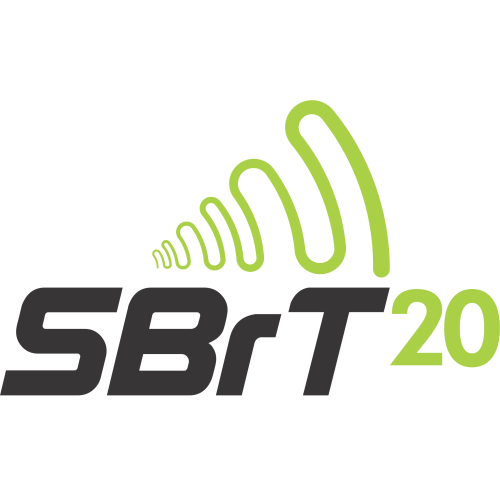
XXXVIII Simpósio Brasileiro de Telecomunicações e Processamento de Sinais

Detecção Hierárquica de Classes Desconhecidas em Sonar por "Autoencoders" Convolucionais
Eduardo Sperle Honorato, Victor Hugo da Silva Muniz, João Baptista de Oliveira e Souza Filho
DOI: 10.14209/SBRT.2020.1570658144
Keywords: Autoencoder Redes Neurais Convolucionais Detecção de Novidades Aprendizagem de Máquina
Abstract
Acoustic waves captured by passive sonar systems are analyzed by human operators, aiming to identify possible threats in the subsea environment. Automatic Classification Systems can aid in the work of this professional, however requiring mechanisms to deal with the presence of unknown classes. This article proposes the use of a hierarchical committee of convolutional autoencoders to build these systems, as a more robust alternative to the k-nearest neighbors algorithm, which represents the state-of-the-art in this problem. Real data belonging to 8 classes of ships under different operational conditions were evaluated. Results signalize a competitive performance of the proposed technique.Download
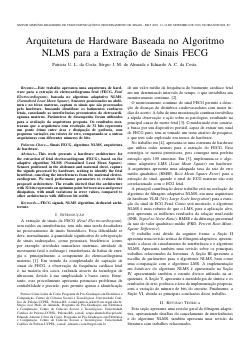
Arquitetura de Hardware Baseada no Algoritmo NLMS para a Extração de Sinais FECG
Patricia U. L. da Costa, Sérgio José Melo de Almeida, Eduardo da Costa
DOI: 10.14209/SBRT.2020.1570658147
Keywords: Sinais FECG algoritmo NLMS arquitetura de hardware
Abstract
This work presents a hardware architecture for the extraction of fetal electrocardiogram (FECG), based on the adaptive algorithm NLMS (Normalized Least Mean Square). Sensors positioned in the abdomen and maternal chest, capture the signals processed by hardware, seeking to identify the fetal heartbeat, canceling the interferences from the maternal electrocardiogram. We used performance parameters to evaluate the proposed architecture. The results showed that the architecture with 32 bits represents an optimum point between area and power dissipation, with small variations in error values, compared to other architectures with different bit-width.Download
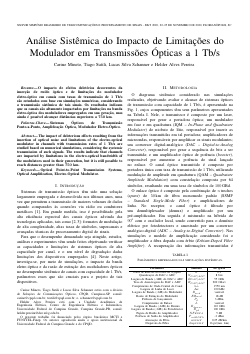
Análise Sistêmica do Impacto de Limitações do Modulador em Transmissões Ópticas a 1 Tb/s
Carine Mineto, Tiago Sutili, Lucas Silva Schanner, Helder A. Pereira
DOI: 10.14209/SBRT.2020.1570658152
Keywords: Sistemas Ópticos de Transmissão Ponto-a-Ponto Amplificação Óptica Modulador Eletro-Óptico
Abstract
The impact of deleterious effects resulting from the insertion of optical noise and limitations of the electro-optical modulator in channels with transmission rates of 1 Tb/s are studied based on numerical simulations, considering the systemic transmission of such signals. The results indicate that channels are impacted by limitations in the electro-optical bandwidth of the modulators used in their generation, but it is still possible to reach distances greater than 750 km.Download
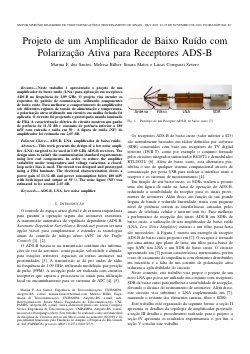
Projeto de um Amplificador de Baixo Ruído com Polarização Ativa para Receptores ADS-B
Marina F Santos, Melissa Bilher, Sinara Matos, Lucas Severo
DOI: 10.14209/SBRT.2020.1570658178
Keywords: ADS-B LNA Low Noise Amplifier
Abstract
This work presents the design of a low noise amplifier (LNA) targeted to be used in 1.09 GHz ADS-B receivers. The design aims to satisfy the communication standard requirements, using low cost components. In order to reduce the amplifier variability under temperature and voltage variations, a closed-loop active bias is used. The circuit was designed and prototyped using a FR4 laminate. The electrical characterization shows a power gain of 11.32 dB and power consumption below 180 mW with both input and output at 50 Ω. The noise figure (NF) was estimated to be around 2.65 dB.Download
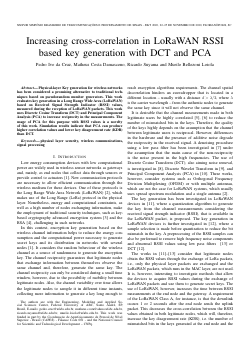
Increasing cross-correlation in LoRaWAN RSSI based key generation with DCT and PCA
Pedro Cruz, Matheus C Damasceno, Ricardo Suyama, Murilo Bellezoni Loiola
DOI: 10.14209/SBRT.2020.1570658181
Keywords: physical layer security wireless communications signal processing
Abstract
Physical-layer Key generation for wireless networks has been considered a promising alternative to traditional techniques based on pseudorandom number generators. This work evaluates key generation in a Long Range Wide Area (LoRaWAN) based on Received Signal Strength Indicator (RSSI) values, measured during the reception of LoRaWAN packets. This work uses Discrete Cosine Transform (DCT) and Principal Component Analysis (PCA) to increase reciprocity in the measurements. The usage of PCA for this purpose with RSSI values is a novelty in this work. Simulation results indicate that PCA can produce higher correlation values and lower key disagreement rate (KDR) than DCT.Download
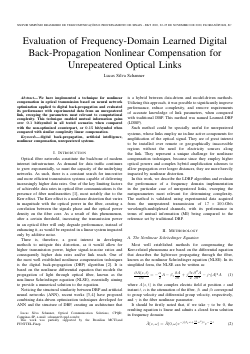
Evaluation of Frequency-Domain Learned Digital Back-Propagation Nonlinear Compensation for Unrepeatered Optical Links
Lucas Silva Schanner
DOI: 10.14209/SBRT.2020.1570658182
Keywords: digital back-propagation artificial intelligence nonlinear compensation unrepeatered systems
Abstract
We have implemented a technique for nonlinear compensation in optical transmission based on neural network optimization applied to digital back-propagation and evaluated its performance with experimental data from an unrepeatered link, sweeping the parameters most relevant to computational complexity. This technique enabled mutual information gains over 0.1 bit/symbol in all tested scenarios when compared with the non-optimized counterpart, or 0.15 bit/symbol when compared with similar complexity linear compensation.Download
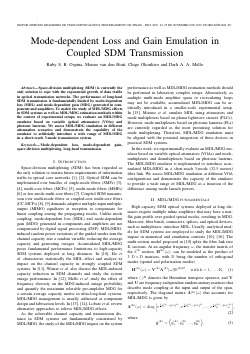
Mode-dependent Loss and Gain Emulation in Coupled SDM Transmission
Ruby Stella Ospina, Menno van den Hout, Chigo Okonkwo, Darli Mello
DOI: 10.14209/SBRT.2020.1570658187
Keywords: Mode-dependent loss mode-dependent gain space-division multiplexing long-haul transmission
Abstract
Space-division multiplexing (SDM) is currently the only solution to cope with the exponential growth of data traffic in optical transmission networks. The performance of long-haul SDM transmission is fundamentally limited by mode-dependent loss (MDL) and mode-dependent gain (MDG) generated in components and amplifiers. To enable the study of MDL/MDG effects in SDM systems as well as MDL/MDG estimation methods within the context of experimental setups, we evaluate an MDL/MDG emulator based on variable optical attenuators (VOAs) and photonic lanterns. We assess MDL/MDG emulation in different attenuation scenarios and demonstrate the capability of the emulator to artificially introduce a wide range of MDL/MDG in a short-reach 3-mode transmission system.Download
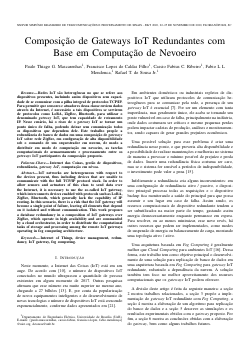
Composição de Gateways IoT Redundantes com Base em Computação de Nevoeiro
Paulo Thiago G Mascarenhas, Cassio Fabius Cambraia Ribeiro, Francisco de Caldas Filho, Fabio Lúcio Lopes de Mendonça, Rafael Timoteo de Sousa Junior
DOI: 10.14209/SBRT.2020.1570658196
Keywords: Internet das Coisas gestão de dispositivos redundância gateway IoT
Abstract
Redes IoT são heterogêneas no que se refere aos dispositivos presentes, incluindo assim dispositivos sem capacidade de se comunicar com a pilha de protocolos TCP/IP integral. Para permitir que sensores e atuadores dessa classe enviem dados através da Internet, é necessário utilizar o denominado gateway IoT, que atua na interconexão dos dispositivos capacitados com protocolos como LoRA, ZigBee, Bluetooth, que geralmente sem a capacidade de roteamento IP. Nesse cenário, ha o risco de o gateway IoT se tornar um ponto único de falha, podendo deixar todos os elementos que dependem dele isolados e sem comunicação. Este trabalho propõe uma composição de gateways IoT sobre ZigBee, que operam em alta disponibilidade e são comandados por um orquestrador em nuvem, de modo a distribuir as tarefas computacionais de armazenamento e processamento entre com os gateways remotos operando em arquitetura de fog computing.Download

Context Selection for Lossless Compression of Bi-Level Images
Evaristo Ramalho, Eduardo Peixoto
DOI: 10.14209/SBRT.2020.1570658199
Keywords: Context Adaptive Binary Arithmetic Coding Lossless Compression JBIG
Abstract
Bi-level images are used in many fields to represent binary masks for object and region of interest coding, enhancement layers of color images and point cloud occupancy maps as geometry slices. Compression of bi-level images is usually performed using context adaptive arithmetic coding. In this paper, we propose a low complexity context selection algorithm that chooses, for each image being encoded, the most useful contexts for encoding that particular image. This information is then transmitted in the bitstream at the cost of 16 bits. Results show that the proposed algorithm outperforms the typical, fixed contexts for natural images and, by a larger margin, for point cloud geometry slices.Download

The wireless signal propagation in hybrid PLC-wireless channels: A first analysis
Gustavo Albuquerque, Hugo Oliveira, Antônio Picorone, Thiago Oliveira, Luis Guilherme Costa, Moises Vidal Ribeiro
DOI: 10.14209/SBRT.2020.1570658204
Keywords:
Abstract
This work advances the study of indoor hybrid PLC-wireless channels when the frequency band delimited by 1.7 MHz and 100 MHz is taken into account. In this sense, a measurement campaign was carried out in a building facility to investigate the wireless signal propagation of these kind of channels. Based on the collected measures of PLC-wireless channels and additive noises, it is reported a agreement with previous works, in terms of average channel gain, power spectral density of additive noise and achievable data rates. Also, numerical results show that wireless signal propagation part of PLC-wireless channels can offer several hundreds of Mbps if a wireless device is located more than 6 meters from the power lines. Also, they show that PLC-wireless systems can be powerful tools to benefit wireless communication inside an office.Download